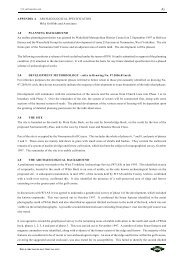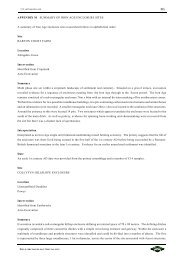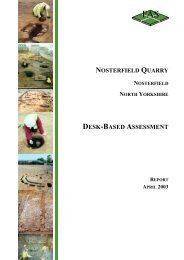ARCHAEOLOGICAL EVALUATION - Mike Griffiths and Associates
ARCHAEOLOGICAL EVALUATION - Mike Griffiths and Associates
ARCHAEOLOGICAL EVALUATION - Mike Griffiths and Associates
You also want an ePaper? Increase the reach of your titles
YUMPU automatically turns print PDFs into web optimized ePapers that Google loves.
FAS_lbf01.wpd 101<br />
No features were identified within Intervention 22.<br />
8.2.17 Intervention 23<br />
Intervention 23 was located in Zone C in the southwestern<br />
corner of the site. The trench was positioned to investigate two<br />
anomalies identified by the magnetometry survey, which had<br />
been partially excavated within Interventions 17 <strong>and</strong> 18 ( being<br />
Intervention 4, F28 <strong>and</strong> 29=Intervention 17, F12 <strong>and</strong><br />
Intervention 18, F13) (see Figure 36). This machine-excavated<br />
trench measured 100m x 4m <strong>and</strong> was orientated north-south<br />
(Plate 24). The ground surface in the area of the trench was<br />
fairly level at c.42.50m AOD. The dark yellowish-brown gravel<br />
<strong>and</strong> clayey silt ploughsoil (C1123) was found to be c.0.30m<br />
deep. The underlying natural subsoil consisted of an<br />
Plate 24 Intervention 23 looking north (scale<br />
2m)<br />
homogenous orangish-brown gravel <strong>and</strong> clayey silt subsoil with small areas of cleaner clay towards the southern<br />
end of the trench (C1124).<br />
Six features were identified within Intervention 23 (F15, F16,<br />
F17, F18, F19, F22) (Figure 58). F15 was situated 45.60m from<br />
the northern end of the intervention <strong>and</strong> was defined as a suboval<br />
deposit of friable dark brown s<strong>and</strong>y-silt (Plate 25). The<br />
feature measured 0.50m long by 0.30m wide <strong>and</strong> upon<br />
excavation proved to be 0.10m deep, backfilled with C1197<br />
(Figure 59). C1197 consisted of a sterile dark brown s<strong>and</strong>y silt<br />
with occasional pea gravel inclusions <strong>and</strong> rare charcoal flecks.<br />
No dateable material was recovered from F15. F15 was<br />
interpreted as a possible small truncated scoop or pit.<br />
Plate 25 F15, Intervention 23, looking east<br />
(scale 0.3m)<br />
F16 was situated 4.80m to the south of F15 <strong>and</strong> was defined as a small sub-circular deposit of dark yellowishbrown<br />
s<strong>and</strong>y silt. The feature measured c.0.56m in diameter <strong>and</strong> upon excavation proved to have near vertical<br />
sides <strong>and</strong> a flat base, being 0.40m deep. The feature was half-sectioned approximately east-west <strong>and</strong> was found<br />
to contain Neolithic pottery <strong>and</strong> lithic material <strong>and</strong> following recording the remaining half was excavated to<br />
recover all material <strong>and</strong> the full form of the feature. The feature contained two backfills allocated C1190 <strong>and</strong><br />
C1191. C1191 was the earliest backfill <strong>and</strong> consisted of a dark greyish-brown silty s<strong>and</strong> with occasional fine<br />
gravel <strong>and</strong> charcoal flecks throughout. A small assemblage of pottery was recovered from C1191 <strong>and</strong><br />
assessment identified three vessels. A deep bag-shaped vessel with carination was represented <strong>and</strong> thought to<br />
be Grimston ware. A thin-walled flat-based <strong>and</strong> flared sided vessel made of a quartz-gritted fabric was also<br />
identified. A third vessel was also represented but was weathered <strong>and</strong> appeared to be a thick-walled vessel made<br />
in a calcite-gritted fabric. A total of eleven flint flakes <strong>and</strong> one chert flake were recovered from C1191 during<br />
excavation, some of which appeared to have been utilised. An end scraper <strong>and</strong> a leaf-shaped arrowhead assigned<br />
to Green’s type series 3A were also recovered. Overlying C1191 was a second backfill which consisted of a<br />
dark yellowish-brown silty s<strong>and</strong> <strong>and</strong> contained occasional fine gravel inclusions. No ceramic was recovered<br />
FIELD ARCHAEOLOGY SPECIALISTS







